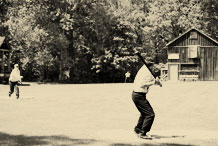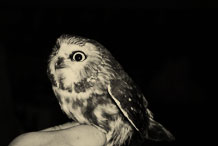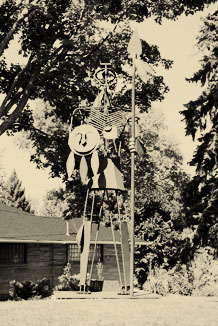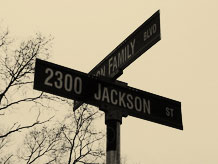
Illustration by Sophia Rapata [photo by Sophia Rapata]

Where there's smoke…
October 30, 2012
It was late when Oscar Timm spotted the hot journal box. The train was only two to three miles from its destination, the Gibson Rail Yard, when he flagged the engine to stop. A hot Journal box must be taken care of. When the wheel bearings encased in the box get hot it can lock up and derail the train, or worse, cause a fire. Gasper pulls the train partially onto a side track, located in Ivanhoe, between Gary and Hammond. Remaining on the main tracks are the sleeper cars and caboose.
As protocol demands Oscar dismounted the caboose with a lantern in hand to place warning flares and emergency torpedoes, sometimes called train torpedoes, behind the train. These torpedoes are placed on the tracks which explode as another train runs over them to warn the engineer of any preceding danger that may lie ahead.
Oscar Timm was seven hundred feet from the caboose when something in the distance caught his attention. Dark silhouetted plumes blow and billow above the tree tops. A train! He is immediate to react. Quickly, he checks his flares. They are burning brightly. As he lights a fuse, he spots the headlight. Waving the fuse in one hand, the lantern in the other, he shouts and charges towards the oncoming train.
No train whistle blows to confirm Oscar has been spotted. The engineer hasn’t seen him. He than jumps to the other side of the tracks in hopes of warning the fireman that sits opposite of the engineer in the cab of the train. He shouts and waves frantically. Again… no whistle.
Oscar Timm again leaped back to the opposite side of the tracks in one final act of desperation. He takes the lit fuse and throws it, aiming to get it into the window of the engine hoping to gain the engineers attention. It is a good throw. It is on its mark. It HITS the closed window and bounces off in a shower of sparks.
Engineer Gaspar and brakeman Aust sees the failed attempt of Oscar Timm from the cab of Engine Extra 7826. Impact is imminent. They jump from the engine and run towards the caboose.
Oscar, heart sinking, watches as the locomotive lumbers on towards the circus train and its unassuming tenants, sleeping peacefully in their beds.
Train master Whipple watches in horror from the back platform of the caboose as the lit fuse bounces off the train. The troupe engine charges closer and closer. Whether Whipple jumps or is thrown from the train, he was unable to recollect. One hundred and fifty tons of runaway train careens into the stopped circus train and its sleeping inhabitants.
At 3:58 in the early morning of June second, 1918 the worst circus train wreck occurred. Those who saw the train coming were witness to the horror that happened next. The cow catcher of Engine Extra 8485, pulling an empty troupe train caught under the caboose of Engine Extra 7826 of the Hagenbeck-Wallace circus. The metal caboose twisted and warped and pushed into the next car, sleeper number five. The wooden car splintered into tiny pieces. Sleeper number sixteen was next and it shattered. Car fifteen split down the middle. Car seventeen had been partially damaged. What was experienced from the inside of those cars must have been maddening. Engine 8485 was only moving at 25 miles per hour, but the bulk pushed it through the bulk of the circus train four to five hundred feet from the initial impact. This was bad. The worse was just starting. It could have been the oil or kerosene lamps. Perhaps it was the battery that powered the electric lights. It may have been the fire box from the troupe train. It could have been a combination. The real cause is unknown. What was known is that a small fire started. Dry and splintered wood from the sleeper cars, however, fuelled it to a raging inferno.
Henry Miller, first assistant light manager, was asleep in the last car, right before the caboose. The sound of splintering wood woke him. Next came three crashes as he was throttled around in his sleeping bunk. He found himself on top of a wreckage of twisted metal, shattered wood and beams. Everything was dark and quiet.
He began his descent down the side of the large mound of debris. Part way down he spied the hand of a trainman who went by the name of “Hickory” poking out of the rubble. Henry tried to pull him free. Hickory in protest told Henry to leave him. It was then that Henry spotted a glow of fire starting to spread across the dry, splintered wood of the wrecked train cars. First it crept, and then it started to leap. Frantic, Henry pulled and pulled.
Just as the flames were starting to reach and wrap around Hickory, Henry pulled him out. They tumbled down the side of the broken hill of horror and landed in a ditch that ran along side of the tracks. Helplessly they sat and watched the debris burn. They could hear the tortured hollers and screams of the people trapped inside.
“Big Joe” Coyle came to on the side of the tracks. Somehow he was thrown from the train during impact. Slightly injured, he came to his feet. His last memory of his family was his wife taking one of his sons to use the facilities. A small cry snapped him to attention. “Oh Papa, help me out of here!” It was his son, “Little Joe.”
Tune in tomorrow for part four of our feature.








